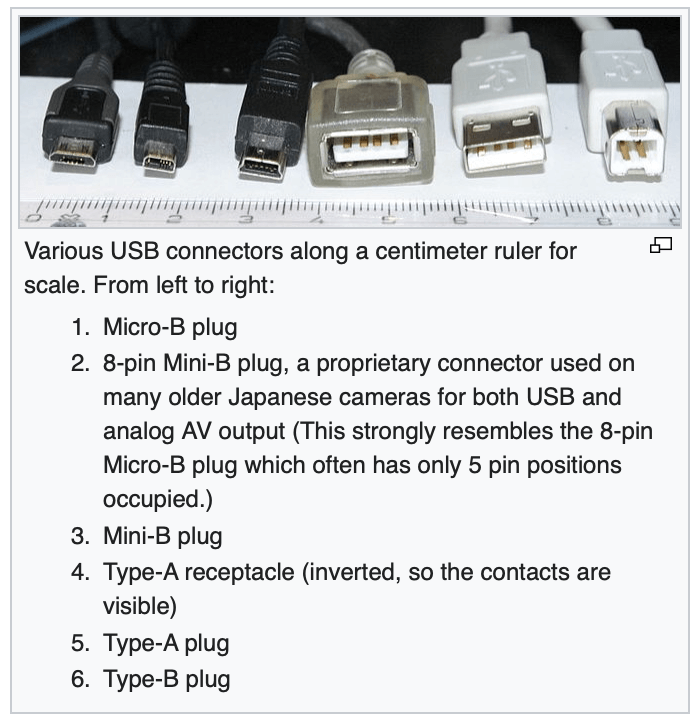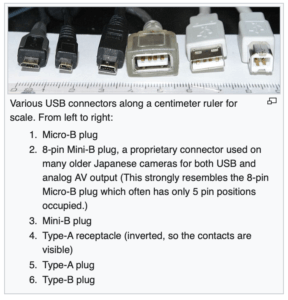
Why are there so many different colored USB ports? And what’s it connect on the mother-side? Rainbows of USB-in’s, can seem elusive, but that’s why I’ve written this guide! So USB, we’re told, will be the one used universally but which USB will it be?
“USB” stands for “Universal Serial Bus” is actually referring to the series of specifications, protocol, and interfaces for hardware set by industry standards.
In most cases, white USB ports are Type A USB 1.x. Introduced in 1996, Type A USB 1.x is the oldest USB standard. A data transfer rate of 1.5 Mbit/s – 12 Mbit/s is available only in one direction. It was initially developed only for low-speed devices like keyboards and mice. From initial data transfers, they support both synchronous and asynchronous transfers. Th’e white USB ports also include hot-plug and play functionality.
Black USB Port / Connector
Black USB ports are usually Type B USB 2.x and are the second specification of USB introduced in 2000. Its max speed is 480 Mb/s and data transfer is available in one direction only. They are called high-speed USBs and are considered to be “backward compatible” with USB 1.1, meaning that when you connect USB 2.x devices to USB 1.x, the device will behave as it did before. It has all the same features as the white USB port. The Black USB port is more reliable than the white USB port. In general, Black USB ports are 40 times faster than White USB 1.x ports. Several device types are supported by USB 2.0 Type B, such as external keyboards, mice, speakers, microphones, external hard drives, CD-RWs, DVDs, tape-drives, digital cameras, etc.
The Internet Patrol is completely free, and reader-supported. Your tips via CashApp, Venmo, or Paypal are appreciated! Receipts will come from ISIPP.
Blue and Teal USB Ports / Connectors
USB 3.x refers to the Third Specification, which exists in two versions: USB 3.0 and USB 3.1. Blue USB ports represent USB 3.0, also known as SuperSpeed (SS) USB ports which boast the symbol “ss” near the port. In theory, its maximum bandwidth is 5.0 Gbps. This seems like it would be 10 times as fast as USB 2.0. In practice, however, it doesn’t allow for even 5 Gbps. The Blue USB 3.0 Port is also backward compatible with USB 1.1 and USB 2.0 devices. These perform “duplex communications”
(If you’re like me, the term “duplex communications” may bringforth visions of tenants talking over one another… Remember the context is standardized hardware.) “Duplex communications” in plain English —— it can read and write simultaneously. (Just like me, too!)
Their twin, the teal USB port, performs all the same features with the only difference that it is also backwards compatible with their predecesor, blue 3.0 ports.
In the event that you have both USB 2.0 and USB 3.0 ports on your computer, always connect high-speed devices supporting USB 3.x, for instance, an external hard disk, to the USB 3.x port in order to achieve higher HDD performance. And use low-bandwidth devices like mice and keyboards with USB 2.0.
Red USB Port / Connector
There are only a few computer motherboards available on the market that have red USB ports. They are USB 3.1 Gen 2 and USB 3.2 Normal ports like Blue Color, Blue Color, and Black Color USB ports don’t provide/deliver power when your laptop/desktop is power-off or sleeping or hibernating. But these Red Color USB ports get power even if your laptop is off, sleeping or hibernating. Due to this, these USB Ports are called Sleep and Charge Ports or Always On Ports.
They have a high transfer rate of up to 20 Gbps, making them the fastest USB port available to date.
Yellow USB Port / Connector
Yellow USB ports are the most common on laptops. This is because they indicate they are always on, which means they will continue to draw power even if the computer is turned off or put to sleep.
This snippet into the life and theory of colored USB ports is a meager, but practical bit of knowledge about the USBs that we are more likely to encounter in our daily lives. I hope this article has cleared up any grey-area hovering around those colorful USB ports.
(No Muppets were involved in developing this article.)
The Internet Patrol is completely free, and reader-supported. Your tips via CashApp, Venmo, or Paypal are appreciated! Receipts will come from ISIPP.










